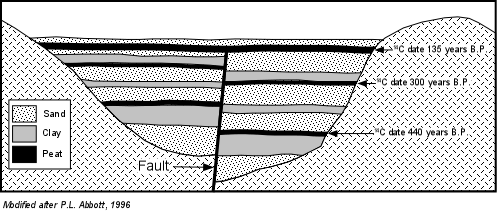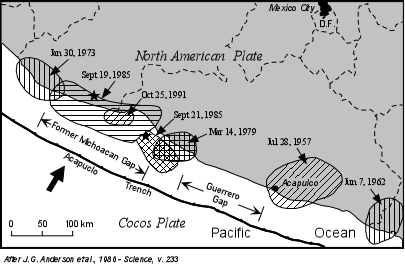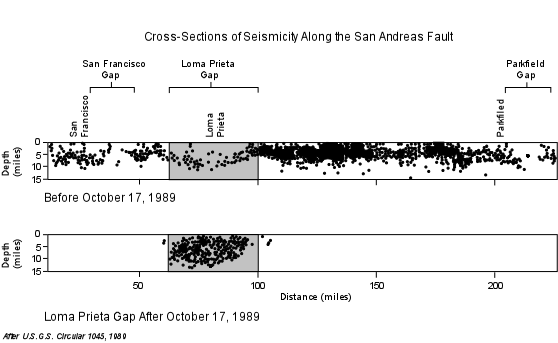In the 2011 Moment Magnitude 9.0 earthquake in Japan, severe shaking continued for 3 to 5 minutes. (See http://www.scientificamerican.com/article.cfm?id=fast-facts-japan)
Building Resonance
Consider that Seismic waves cause the ground to vibrate at frequencies between 20 and 0.002 cycles per second which translates to periods (time to complete one cycle) of between 0.05 seconds and several minutes. All structures have natural frequencies or periods of vibration. If a structure has a period of vibration similar to a seismic wave it will resonate, and the longer it resonates, the more likely it will fail.
Resonance can be eliminated by:
- Changing the height of building
- Moving weight to lower floors
- Changing the shape of building
- Changing the building materials
- Changing how the building attaches to foundation.
- Hard foundation (high-frequency vibrations) - build tall, flexible building
- Soft foundation (low-frequency vibrations) - build short, stiff building
Horizontal Shaking
P-waves, as they arrive at the surface, generally cause the ground to move up and down. But S-waves and Surface Waves cause the ground to move from side to side as well as up and down. The horizontal movement, causes different parts of building to move in different directions. Problems with buildings can be eliminated by using shear walls – designed to receive horizontal forces from floors, roofs and trusses and transmit them to the ground.
Building a house of cards illustrates this point well. A house of cards will stand on its own, but will fall apart of you shake the foundation. If the cards are taped together, so that the vertical components and horizontal components are connected together, the house of cards will not fall over if you shake the foundation.
The structure and also be isolated from the underlying ground by base isolation, wherein devices on the ground or within structure are placed to absorb part of earthquake energy. This can be done by installing wheels, ball bearings, shock absorbers, ‘rubber doughnuts’, etc. to isolate building from worst shaking.
Concrete and Steel Construction Materials
Large buildings are often constructed with concrete reinforced by steel rebar.
Concrete is strong under compression, but weak under extension or shearing. Steel reinforcement of concrete can help prevent failure, but must be done in such a way to prevent motion both horizontally and vertically. For example, bridges supported by vertically embedded rebar in the support structures can easily fail when subjected to horizontal vibrations, as illustrated by the freeway collapse in the 1989 Loma Prieta earthquake near San Francisco. But, if the vertical rebar is surrounding by rebar spiraling around the vertical rebar, the structure will have more resistance to horizontal movement.
Bridges
Cantilever type bridges, like a portion of the Bay Bridge from Oakland to San Francisco or the Crescent City Connection in New Orleans where towers support the bridge are more susceptible to damage than suspension bridges, like the Golden Gate Bridge in San Francisco, where more flexible steel cables support the bridge deck. In cantilever type bridges, since the towers are fixed, they can move apart during an earthquake, causing the bridge deck to collapse. The more flexible steel cables of a suspension bridge allow the deck to sway with the vibrations and therefore resist failure.
Utilities
Water supplies are often cut off as water pipes break during and earthquake. Failure of the water supply prevents control of secondary fires and slows recovery. Constructing the water supply system wi ht flexible joints can prevent breakage of pipes. Gas mains and electrical meters can be fitted with devices that shut off natural gas automatically at the first sign of shaking. This will also aid in the prevention of secondary fires.
Houses
Modern 1 and 2-story wood-frame houses generally perform well in earthquakes, but they can perform better if additional support is provided by building shear walls, bracing, and tying walls, foundations and roof together.
Even if the house does not fall down during an earthquake, interior furnishings can cause considerable damage and injury as interior items are thrown about during the shaking. Thus, it is essential to bolt down water heaters, air conditioning/heating unites, ceiling fans, cabinets, bookshelves, and electronics, basically anything that can fall or collapse and cause injury.
Summary
While architecture & building codes reduce risk, not all kinds of behavior can be predicted. For example: different earthquakes show different frequencies and durations of ground shaking, & different vertical & horizontal ground accelerations.
Old buildings cannot cost-effectively be brought up to code, especially with yearly refinements to code. And, even with construction to earthquake code, buildings fail for other reasons - like poor quality materials, poor workmanship, etc., that are not discovered until after an earthquake.
What To Do Before and During an Earthquake
Every person living in areas susceptible to earthquakes should be educated in steps they can take to minimize risk, before, during and after an earthquake. These steps are discussed in detail on FEMA web pages - see https://www.ready.gov/earthquakes and are briefly summarized here, but you should check the website for important details.
Before an Earthquake
- Check for Hazards in the Home - look for items that might fall, dangerous substances that might spill, items that might shatter, faulty electrical and gas connections, etc. and secure or repair any deficiencies.
- Identify Safe Places Indoors and Outdoors - Find places where you can go to protect yourself, such as under a heavy desk or table, away from glass, and away from buildings, structures, poles, etc. that might collapse.
- Educate Yourself and Family Members - make sure everyone knows what to do in the event of an earthquake.
- Have Disaster Supplies on Hand - things like flashlights and batteries, first aid kits, emergency food and water, medicines, cash, etc.
- Develop an Emergency Communication Plan - remember telephone communication (even cell phones) may not work.
During an Earthquake
Be aware that some earthquakes are actually foreshocks and a larger earthquake might occur. Minimize your movements to a few steps to a nearby safe place and if you are indoors, stay there until the shaking has stopped and you are sure exiting is safe.
If indoors - drop and cover - get under a sturdy table, hold on until the shaking stops, crouch in an inside corner if no other protection is available, stay away from glass and anything else that might shatter or fall. DO NOT use elevators.
If outdoors - Stay there.
Move away from buildings, streetlights, and utility wires or anything else that may fall on you.
If in a moving vehicle - Stop as quickly as safety permits and stay in the vehicle. Avoid stopping near or under buildings, trees, overpasses, and utility wires.
Proceed cautiously once the earthquake has stopped. Avoid roads, bridges, or ramps that might have been damaged by the earthquake.
If trapped under debris - Do not light a match.
Do not move about or kick up dust.
Cover your mouth with a handkerchief or clothing.
Tap on a pipe or wall so rescuers can locate you. Use a whistle if one is available. Shout only as a last resort. Shouting can cause you to inhale dangerous amounts of dust.
After an Earthquake
- Expect aftershocks which can cause more damage and injury.
- Listen to a battery-operated radio or television for the latest emergency information.
- use the telephone only for emergency calls.
- Open cabinets cautiously.
- Stay away from damaged areas.
- Return home only when authorities say it is safe.
- Be aware of possible tsunami if you live in coastal areas.
- Help injured or trapped persons
- Do not move seriously injured persons unless they are in immediate danger of further injury. Call for help.
- Clean up spilled medicines, bleaches, gasoline or other flammable liquids immediately. Leave the area if you smell gas or fumes from other chemicals.
- Inspect utilities,
Check for gas leaks, look for electrical system damage, check for sewer and water supply damage.
Awareness of this information is essential to saving your life! Note that most of this information is applicable to only to earthquakes but other natural disasters as well.
|


